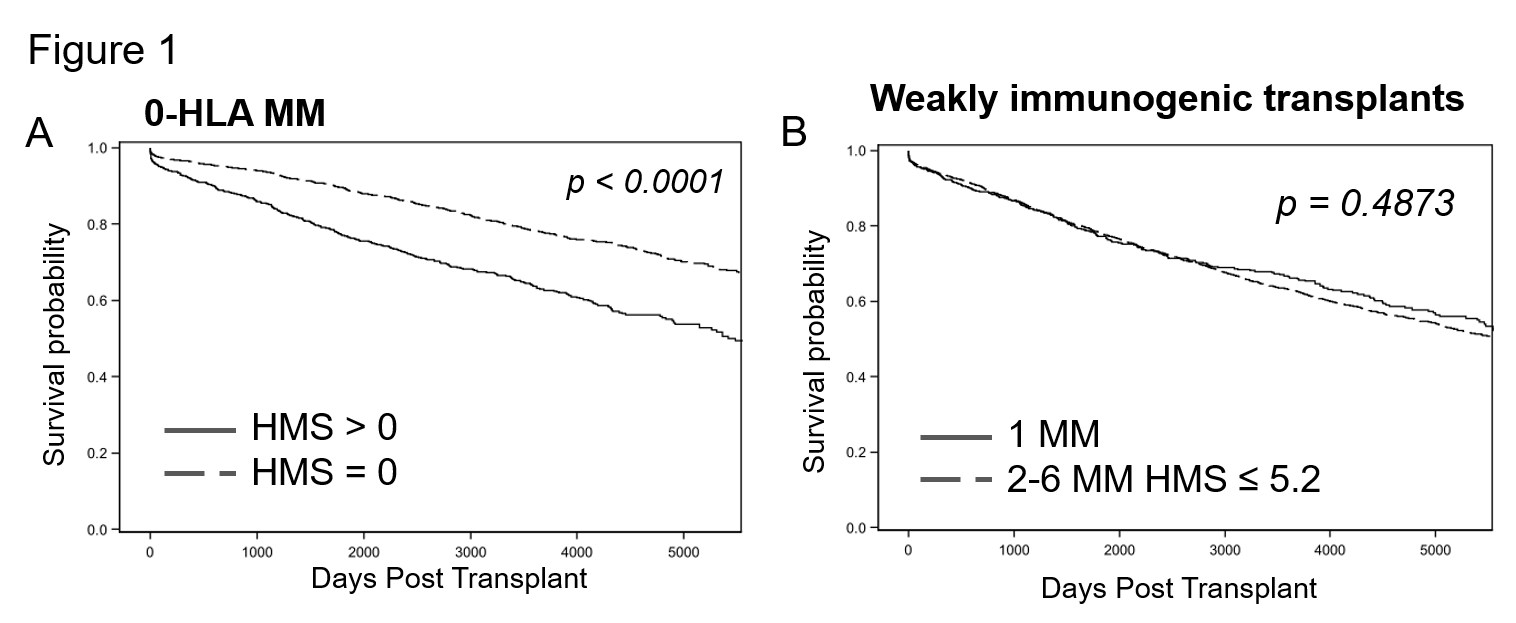Physiochemical Hla Properties Identify Low Immunogenic Donor/recipient Pairs Predicting Long-term Kidney Graft Survivals
1Gift of Life Michigan, Ann Arbor, MI, 2University of Toledo, Toledo, OH
Meeting: 2019 American Transplant Congress
Abstract number: 164
Keywords: Allocation, Immunogenicity
Session Information
Session Name: Concurrent Session: Histocompatibility and Immunogenetics
Session Type: Concurrent Session
Date: Sunday, June 2, 2019
Session Time: 4:30pm-6:00pm
 Presentation Time: 5:30pm-5:42pm
Presentation Time: 5:30pm-5:42pm
Location: Room 309
*Purpose: Although it is well-recognized that HLA matching improves the long-term kidney graft survival, less than 10% of transplants are currently HLA matched. We measured physiochemical HLA properties to identify low immunogenicity (IM) donor/recipient pairs. The hypothesis is that low IM transplants have better survivals than high IM transplants.
*Methods: The HLA IMM was measured for polymorphic HLA amino acids by physiochemical properties (Cambridge algorithm) as hydrophobic (HMS), electrostatic (EMS) and amino acid (AMS) mismatch scores. We converted 2- to 4-digits HLA-A/B/DR of 43,944 recipients of adult primary transplant recipients and 82,416 unadjusted recipients from SRTR database: for all donor/recipient pairs we established their HMS, EMS and AMS values.
*Results: Some of the 2-digit 0-HLA mismatched (0MM) transplants had allelic mismatches after 4-digit conversion establishing two groups: those with 4-digit 0MM (HMS=0) with the median death-censored graft survival (GS) of 23.2 years and those with >0MM (HMS>0) and worse GS of 15.0 years (Fig. 1A; p<0.0001). Patients with 1MM (n=907) had the HMS of 5.2 and an excellent GS of 17.6 years. When we selected patients with the HMS value ≤5.2 among 2MM (2,192 patients), 3MM (2,583 patients), 4MM (1,417 patients), 5MM (368 patients) and 6MM (34 patients) groups their GS was also excellent of 17.8 years but with the total number of 7,408 patients (Fig. 1B). Thus, the Oxford method selected 7-fold higher number of low IM pairs. In contrast, patients with HMS >5.2 (n=7,221) had worse survival of 14.7 years (p<0.001). Parallel analysis of 82,416 primary and re-transplanted patients had an HMS of 4.9 for 1MM patients (n=762) with the graft survival of 16.6 years and 15.6 years for 2- to 6MM patients with HMS ≤4.9 (n=15,153). The Oxford method selected 20-fold more patients with low IM transplants. Patients with HMS >4.9 had worse graft survival of 13.2 years (p<0.001).
*Conclusions: The Oxford method calculates HMS value which allows to select patients with low IM correlating with significantly longer graft survivals in comparison with those high IM. This method may be applied to select donors with low IM to benefit large number of patients independent of their 2- to 6-MM status.
To cite this abstract in AMA style:
Bekbolsynov D, Mierzejewska B, Ho C, Rees M, Stepkowski S. Physiochemical Hla Properties Identify Low Immunogenic Donor/recipient Pairs Predicting Long-term Kidney Graft Survivals [abstract]. Am J Transplant. 2019; 19 (suppl 3). https://atcmeetingabstracts.com/abstract/physiochemical-hla-properties-identify-low-immunogenic-donor-recipient-pairs-predicting-long-term-kidney-graft-survivals/. Accessed December 16, 2025.« Back to 2019 American Transplant Congress

